Drogheda & Dublin Years
James Mohan was baptised in Drogheda on the 21st of March 1848. His father was Joseph Mohan and, his mother’s surname was Walsh. Sponsors or Godparents at his baptism were Matthew Murphy and Mary Mohan. My g/grandmother would later name two of her sons James and Joseph, I would suggest after her father and grandfather Mohan.
My research to date is trending toward supporting a hypothesis that the Mohan and Duffy families have enjoyed a long history and association with Drogheda and Dublin. Drogheda being an ancient town in County Louth. At the time that James and Bridget were raising their family in Drogheda it was a predominantly Catholic town in what was still British controlled territory. A time in an Ireland that was hotly agitating if not for complete separation from England at any cost, then certainly for Home Rule.
In 1886 George Henry Bassett put together and had printed in Dublin the Louth County Guide and Directory including the town and county of the town of Drogheda. And sure didn’t Drogheda have a lot going for it as there is a great deal of information in this compendium about the area and the people of the day.
Bassett remarked that the County of the town of Drogheda while being the smallest county in Ireland, deserved to be ranked among its most prosperous. He described the boundaries of the Irish Sea, Drogheda, Dundalk and Greenore featuring extensive and diverse industry. Bassett described the area prior to English plantation as an ancient independent principality named Orgial where the Sept of the O’Carrols had been its princes. It was in 1138 that John de Courcy and de Lacy brought English settlers to occupy the land which they renamed Uriel and Oriel.
In 1210 King John of England declared Drogheda part of Louth. The English settlers were encouraged to build large castles to intimidate the indigenous Irish and to defend the vital ports exporting and importing into Drogheda. At the time that Bassett was in Drogheda it also had as thriving fishing industry. The indigenous Irish inhabitants had been residents since early Celtic times. Evidence of this was found in the many druid stones and archaeology of early Celtic people that were being found and preserved for future generations as early as 1835 which Bassett recorded. Invasion and occupation was not a new concept for the Irish people. Drogheda had previously seen both Viking (Danes) and Roman occupation. The English formed up and included Drogheda in what was then ‘The Pale’ being the boundary of the part of Ireland that was considered England. This wouldn’t last. In 1649 Cromwell and his armies of mercenary troops believed to be ten thousand in number besieged and entered Drogheda butchering thousands of men, women and children. Generations later I still remember that my grandfather had said the worst insult anyone in his mothers family could put on you was ‘the curse of Cromwell be on you:. Harsh.
I had originally expected to find Drogheda in the time of James Mohan and Bridget Duffy to be full of Mohan’s. But I was wrong. Our James Mohan had a blacksmithing forge in Bachelor’s Lane but lived with his family at 31 Millmount Terrace for a time. I did find a C. Mohan with board and lodging at 9 Bull Ring Drogheda. And then no others. A note on Bachelor’s Lane, there were quite a few businesses operating forges and metalworks in this dockside area. Which makes sense as they were supporting the busy shipping industry in Drogheda. I’ve now walked those roads (hills/stairs) and can testify you had to have fit legs to get around, this hillside town and I’d think still do. Parts of the original city walls still meander visibly through Drogheda, and aside from the family history connection, in itself it is a fascinating place full of friendly people, happy to help you on your journey.

Bachelor’s Lane Area, Drogheda Oct 2023 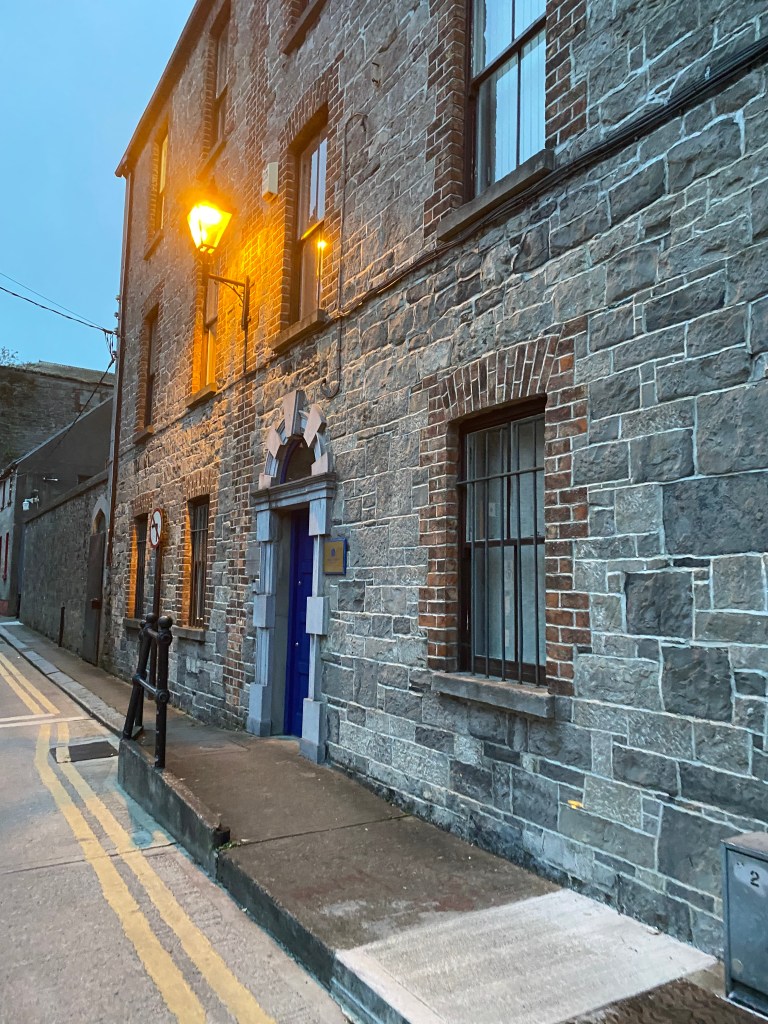

Drogheda Oct 2023 
Drogheda City Walls Oct 2023 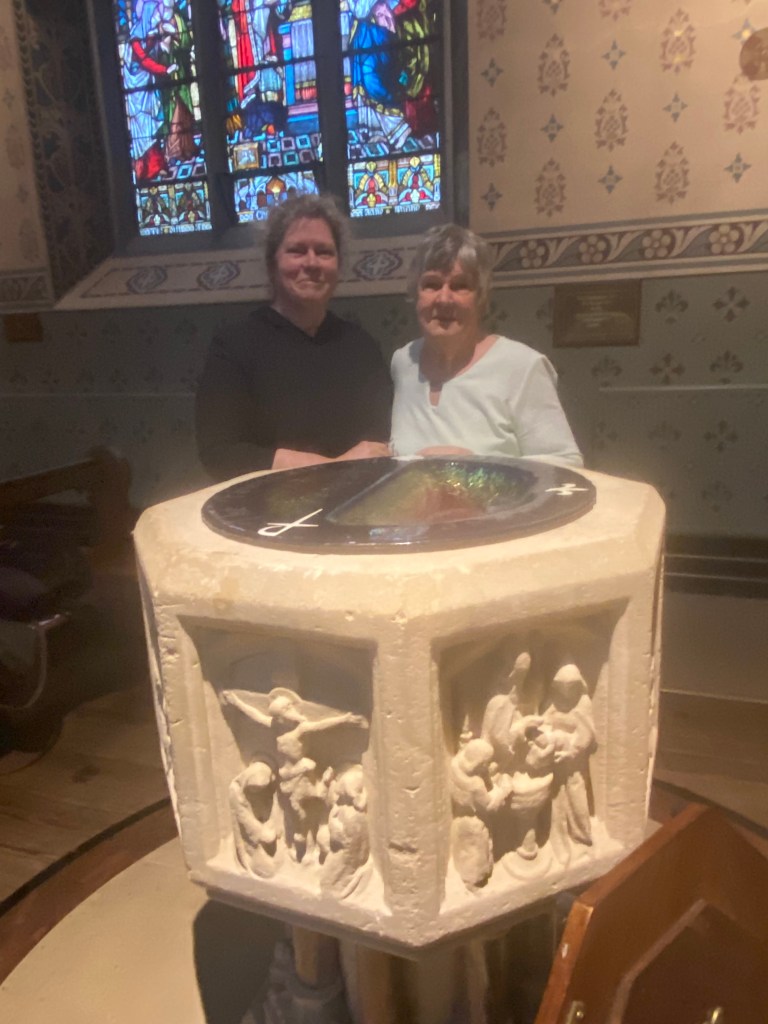
Granddaughter and Great Granddaughter at Font (base) where Mary Alice Mohan was baptised in Drogheda. Oct 2023. 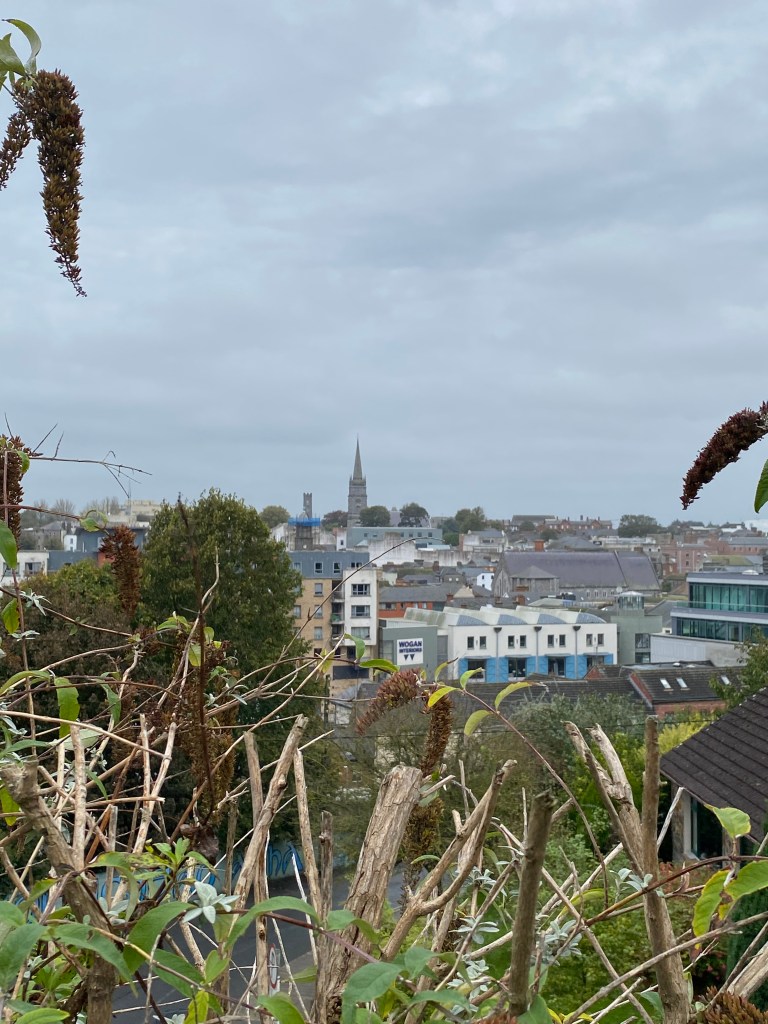
Drogheda City from Millmount Terrace Oct 2023

What I did find was a sprinkling number of James wife Bridget Duffy’s family in Drogheda.
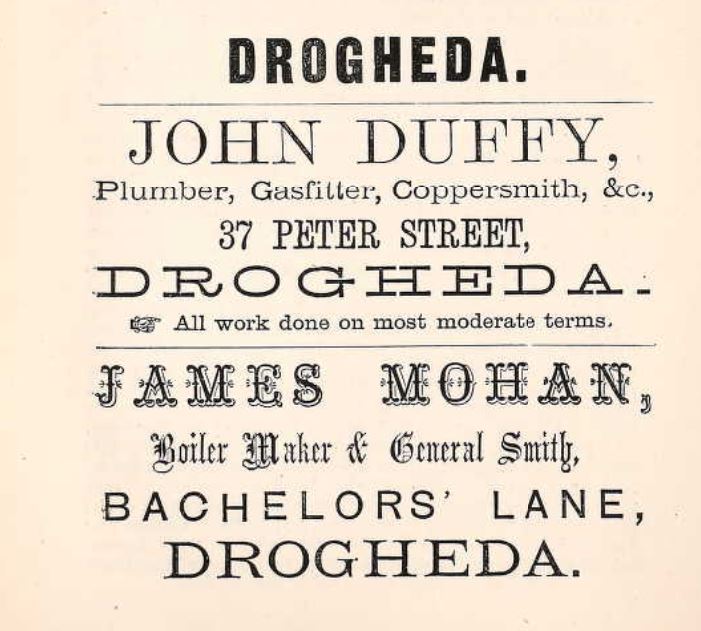
A Duffy and Son, bootmakers, in Abbey Ln. A Mrs Catherine Duffy Trinity St who had a grocery shop. A Mr John Duffy at 37 Peter Street a plumber and gas fitter. Henry Duffy, Master Union (Employee) at the Drogheda Workhouse on Dublin Road (which was in operation at this time).
However eleven miles down the road in Ardee there were substantially more Duffy’s to be found. Mrs M Duffy proprietor of the Ruxton Arms Hotel and General Posting Establishment. A sizeable proprietorship of general grocery, team, wine and spirits and stationary etc. James Duffy who worked some land (Glebe). A John Duffy who was a borough inspector residing on Bridge Street, Ardee.
The nearest operating ‘big house’ to Drogheda was out on Platten Road being Platten Hall. Platten Hall was built around 1700. At the time of our family it was owned by the English/Irish Gradwell family with George Gradwell Justice of the Peace being the current resident. A nearby flax industry was owned and operated by the Gradwell family along with agricultural business. Like the many castles dotting the Drogheda area that had fallen into ruin, Platten Hall would fall into utter disrepair before being demolished in the 1950’s.
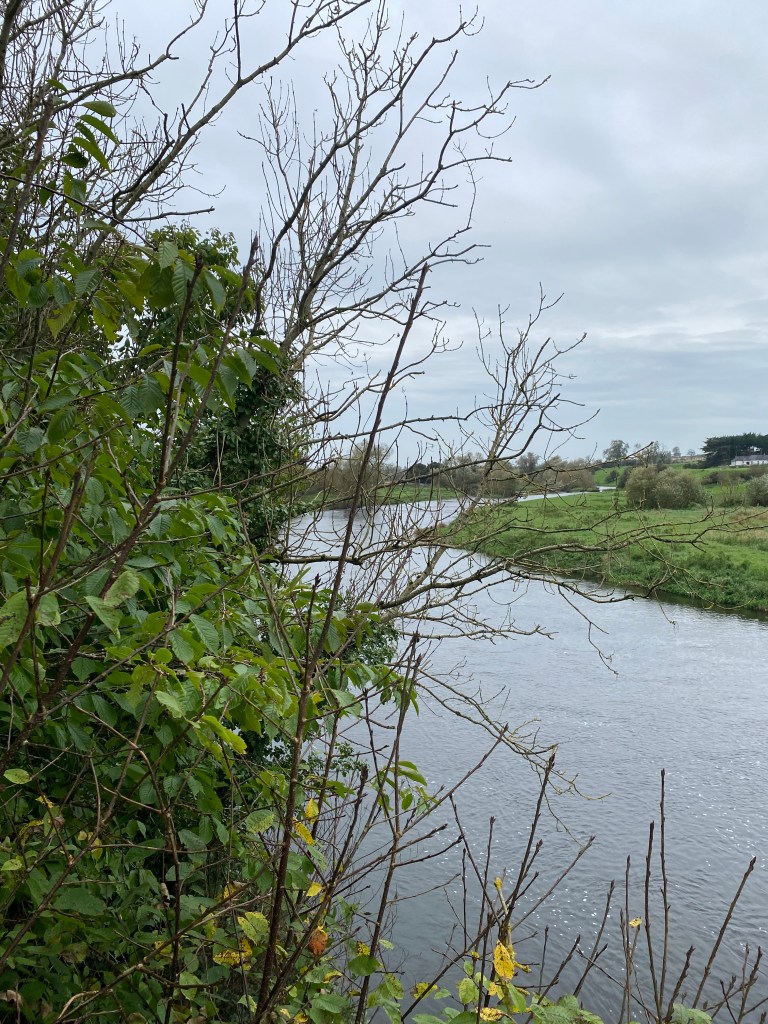
The River Boyne, Co. Meath. Bru Na Boinne, near Drogheda. Oct, 2023.
Bassett remarked in his book that Drogheda, Ardee and surrounding lands were rich in minerals and proved excellent for agriculture. This natural richness of resources and temperate climate of the Boyne valley was able to protect Drogheda a little from the total obliteration that many of the Irish people (especially in western Ireland) would suffer during the devastation of the famine of the 1840’s.

I’ve been able to establish through records including the census, that my branch of the Mohan’s were fiercely patriotic Irish, proudly spoke both Irish and English, could read and write and supported each other through the good and the hard times. My great-grandmother had implored my grandmother (her daughter in law) to keep the family to the Catholic faith that she had so earnestly raised her children in. What I have learned through my research is probably not so much a devout adherence to religion but devout adherence to a set of values that guided how a family should be kept together no matter what. Maybe that is what she meant? I know that one of the last things my grandfather told me before he died was and I quote “keep the family together, family is the most important thing.” I have tried to meet this request. I have come to believe now that this cultural rule came from our Mohan ancestors.


Holly bushes in Co. Louth near Drogheda and St Laurence Gate in Drogheda (Oct 2023).
James and Bridget’s children were baptised in the local family church of St Mary’s Drogheda. James’s occupation was that of a blacksmith. James and Bridget had seven known children. I say that because there may be more. Mary Alice Mohan (b. 1872), Joseph Mohan (b. 1873), James Mohan (b. 1875), Francis Mohan (b. 1877), Peter Mohan (b. 1879), Isabella Mohan (b. 1884), Alphonsa Mohan (b. 1887). From what I can ascertain from records they lived mostly in the area of Mill Mount Terrace in Drogheda in those earliest years. In 1886 James was recorded as a blacksmith living in Bachelors Lane in the Drogheda City and Regional Directory.
Later the family (and at the time of James death in 1898) were living in Coola (Coolagh?) Street in Drogheda. One of their neighbours in Coola Street would have been the Burke family. Tom Burke the famous Irish revolutionary and sportsman was only a little boy when the Mohan family were there. He would go on to form the Drogheda branch of the Ireland Volunteers. His little brother Christopher (also a revolutionary and hunger striker) was a baby when James Mohan died. Like the Mohan’s they would lose their comfortable early life on Coola Street with the death of their father in his forties and the loss of the family income and would have to move away to cheaper accommodation. The Mohan’s would have known of Tom and Christopher Burke and their family with it being probable that their sympathies ran alike.
On the 27th of July 1898 James Mohan, blacksmith, died at home in Coola Street having been acutely sick with pneumonia for five plus days. He was forty-six years of age. His son Francis reported his death. To say that life changed significantly for the family would be no understatement.
Visiting Drogheda in October 2023, I did have trouble finding some of these original places which is a natural occurrence as towns and cities develop and reform over time. I was extremely grateful for the wealth of information supplied by the Old Drogheda Society while we were there. Their tour of Millmount Tower and Millmount Museum and knowledge of Old Drogheda was one of the highlights of our trip and not to be missed!
Far from being isolated in Drogheda. I believe it was more likely that Bridget (and the remaining at home family) did what most families who fell onto hard times did, they went and lived with other family members. In Bridget’s case I believe she took her four at home children and moved the twenty-eight miles south to Dublin city where her son James (25) was living with his wife Margaret O’Sullivan and their children at 58 Lower Gardiner Street, North Dock, Dublin North. His sister Mary Alice Mohan would be godmother to one of their children (her niece) Catherine Ethel Teresa Mohan (b. 1898 – d.1900) who died aged one year following two days of convulsions. James and Margaret’s home would be full to the brim with their own remaining little family of Matthew, Michael, James, Patrick and Winifreda. I imagine James and Margaret gave Bridget as much support as they reasonably could.
By the time of the 1901 census, Bridget Mohan and four of her children had relocated to 61.8 Lower Gardiner Street, North Dock in Dublin North (north of the river Liffey). This was an area that included tenement buildings. It was in one of these tenement buildings that the Mohan’s now resided. They rented two rooms with the five of them living there. Mary Alice was 25, Isabella was 17. Francis 23 had assumed head of house. Alphonsa 14 was a scholar. Bridget marked as married, 50 years of age. Francis gave his trade as blacksmith which had been the same as his father. They could all read and right and except for Bridget they spoke Irish and English. These were not the only family that Bridget had, the area of North Dublin which was well represented by Mohans. 28 October 1902, Thomas Mohan of 42 Lower Gardiner Street Dublin married Alice Byrne also of 42 Lower Gardiner St Dublin. Thomas gave his father’s name as Sylvester Mohan and his mother as Anne Coyle. Bernard Mohan and his family (daughter Catherine Mohan) at 44 Lower Gardiner Street. She married Hugh Jackson (Bookbinder) 14 February 1900 her father Bernard’s occupation was recorded as a Manager. I think Bernard might have been a brother to James Mohan Snr (Bridget’s late husband.)
- The 1901 census revealed of Bridget and the children at 6.18 Lower Gardiner Street were:
- Mohan Isabella Lr. Gardiner Street North Dock Dublin 17 F Drogheda Traveller – Boots, Roman Catholic Read and write Irish and English Daughter Not Married
- Mohan Bridget Lr. Gardiner Street North Dock Dublin 50 F Drogheda No Business at Home Roman Catholic Read and write English Mother Married
- Mohan Alphonsus Lr. Gardiner Street North Dock Dublin 14 M Drogheda Scholar Roman Catholic Read and write Irish and English Son Not Married
- Mohan Mary Alice Lr. Gardiner Street North Dock Dublin 25 F Drogheda Traveller – Boots, Roman Catholic Read and write Irish and English Daughter Not Married
- Mohan Francis Lr. Gardiner Street North Dock Dublin 23 M Drogheda Black – Smith Roman Catholic Read and write Irish and English Head of Family Not Married
With a note to the comment on both Mary Alice and Isabella being ‘traveller boots’ in the census. Initially I thought this meant travelling salespeople. But that just seemed odd for women. A bit more digging could mean that they were with or identified as Irish Travelers? I needed more information for this hypothesis. Family group names and some peer reviewed genealogical papers I was able to source online gave me some more clues. Most common historical Irish Traveler names included Ward, Connors, Carty, O’Brien, Cash, Coffey, Furey, MacDonagh & Mohan. Maybe that was the reason I couldn’t find a well established cohort of Mohan’s over generations in Drogheda. Some more digging generated that Drogheda being on the coast and on the way to Dublin and also hear enough to Belfast was not an uncommon place for travelers to go through as they moved up and down the east-coast.
My aunt has always told a story that her father told her that his Irish mother had told him. That she was from a long line of Irish royalty. She was also remembered by my grandfather as someone who ‘knew things of a spiritual nature & exceedingly devout in her prayers and praying routines. Was she talking about a link to Irish Travelers? Irish Travelers are a distinct group not related to Romani or other European traveler communities. The original Irish Travelers were thought to have emerged as a group that coalesced together following Cromwellian invasions of Ireland and further solidified after the 1840’s famine when families of lower incomes were forced onto the road to travel for work. Thus becoming the Irish Traveling community. Work in repairs and constructive or agricultural work and tin/metal smithing were notable features of this group. James Mohan worked during his time in Drogheda as a blacksmith and was also recorded as a boiler maker. Both metal working.
From my perspective, it would be reasonable that if Mary Alice and Isabella were indeed related to Irish Travelers and Dublin was not an easy place to earn a living for the very poor, tight living conditions and a mother who also had younger children to support, it might have been quite possible that Mary Alice and Isabella joined Mohan relations who were ‘on the road’.
What is also important to know is that my great-grandmother didn’t ever tell her children about the difficulties living in Ireland. For them it was always stories of how wonderful everything was. The stories were embellished shall we say. There was never much of a mention about the old people, so much of what I’ve been able to find out has been through over thirty years of committed research. Putting a ‘face on the place’ was achieved finally this year when I was able to visit in person. To the best of my knowledge no Mohan’s from my great-grandmother’s family came to Australia. She was as far as I ever knew the only one and she did this via South Africa where my grandfather was born.
Tragedy would strike again and in May 1902, 15 year old Alphonsus Mohan was admitted to The Hospice Harold’s Cross in Dublin with Phthisis of one month duration. This was tuberculosis. Almost every entry on the same page of death’s registered (with Alphonsua) was from the same or similar description of the same diagnosis of this highly contagious and terminal disease, rampant in the tenements. The death toll from tuberculosis in the Dublin tenements at this time was astronomical. The National Archives of Ireland record Dublin as having had the most deaths due to tuberculosis in the early 1900’s and the worst housing conditions of any other city in the whole United Kingdom. Nat Arch London. Alphonsus was buried at Glasnevin cemetary in 1902. Finglas Road, Glasnevin, Dublin.
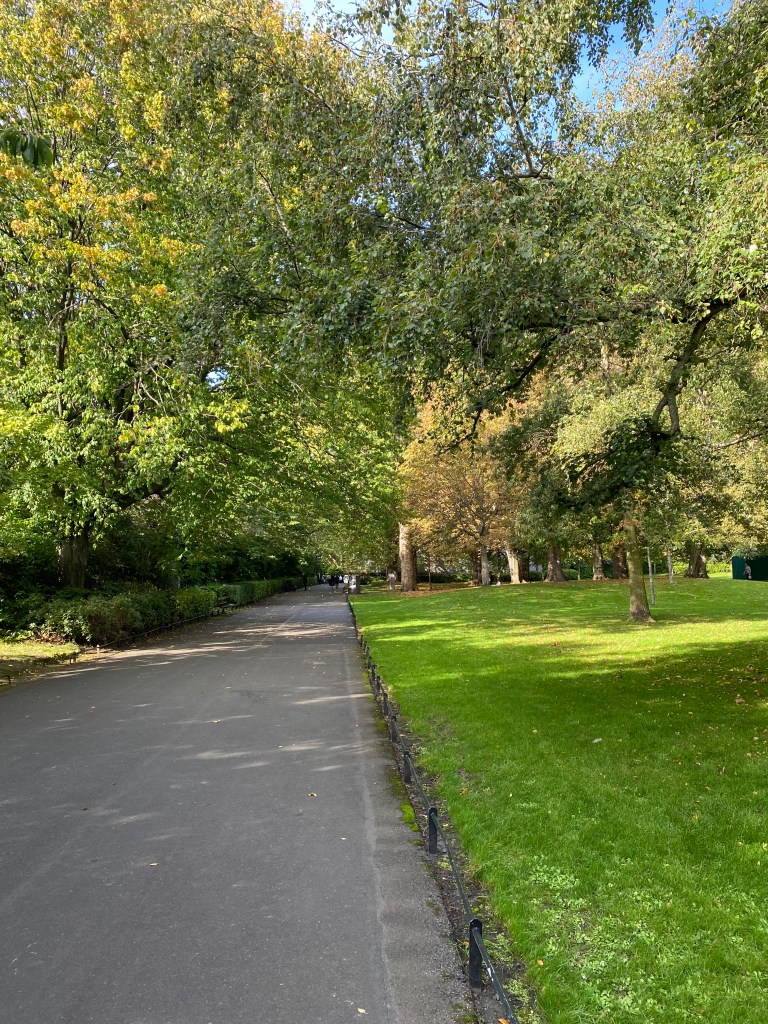
St Stephen’s Green, Dublin, Oct 2023.
From 1902 to 1911 Mary Alice had three known children of her own with husband George Harold or Harold George Cave. These were Evelyn Alice Cave b. 1909 in Ireland (per her death record), Harold George Cave b 1910, and George Alphonsus Cave (known during his life as Roger) b. 1911. Born in Ireland at the Rotunda Hospital in Dublin with his father’s name recorded as Harry Cave a Labourer. The understanding from the family was that Mary had married Harold George Cave who was a protestant and who had been lost in a snowstorm when the children were little. When Mary’s son George Alphonse Cave was born in 1911, she recorded her address as 25 Synnot Place. When her son James Henry Moss was born in 1915 at the Rotunda Hospital, Mary gave her address as 25 Synnot Place, Dublin and her spouse as John Henry Moss aged 41. During these periods of time Mary Alice was not ‘living’ at Synnot Place. She was coming and going. Synnot Place was her mother’s home. She came back to Synnot Place on three definite occasions to have children. I have not been able to date to find any records of George Cave or of Mary Alice being in England or indeed other places in Ireland during these years.
The 1911 Census showed Mrs. Bridget Mohan, aged 67, resided in a large, converted house at 25 Synnot Place. She was recorded as a widow. City of Dublin, North Dublin, Inns Quay, St George Parish, College Green. Bridget reported that she could read and write and was a native of County Louth. That she had had eight children, two of whom were living (?) The building was recorded as a private house with sixteen windows and a permanent dwelling. What’s important to note is that this was tenement housing. Seven families lived in this house conversion. Mary Hamilton occupied one room with a family of three. Mary Reavey occupied one room, a family of one. Kate Hand occupied two rooms a family of two. James Collins occupied two rooms, a family of three. John Keane occupied three rooms, a family of three. Thomas F. Walton occupied one room, a family of two. Bridget Mohan occupied one room a family of one. Mary O’ Kelly occupied twelve rooms a family of three (?) Researching the history of Synnot Place, I’ve been able to locate some records detailing some of its residents during the years the Mohan family were associated with it.
- 1899 25 Synnot Place, Dublin. Elizabeth O’Neill. Rated Occupier,
- 1908 25 Synnot Place, Dublin. House and yard. Michael Sullivan. Rated Occupier,
- 1910 25 Synnot Place, Dublin. John Kane. Rents top floor.
- 1911 25 Synnot Place, Dublin. John Kane. Top floor inhabitant.
- 1912 25 Synnot Place, Dublin. House and yard. Michael Sullivan. Rated Occupier.
- 1913 25 Synnot Place, Dublin. House and yard. Michael Sullivan. Rated Occupier (crossed out),
- 1913 25 Synnot Place, Dublin. James Collins inhabitant/householder. First Floor.
- 1914 no entries for number 25.
- 1915 no entries for number 25 – Mary Alice Mohan gave this address as her home address when her son James was born.
In the 1911 Census, Mary Alice’s younger brother Francis Mohan resided at a house (number 14) in Abercorn Road, Off Sheriff Street, Upper (North Dock, Dublin). Along with his wife Mary, aged 34 and also of County Louth. Their children, Mary Frances (aged 8) a scholar born in Dublin City. Their son William (aged 6) a scholar born in Dublin City. A son Francis aged 3 born in Dublin City a daughter Annie aged 2 born in Dublin City. They also had a boarder Patrick Curran aged 31 who resided with them. Francis had three rooms and seven of them living there. He gave his occupation as a blacksmith. Below is a one hour simply amazing documentary from RTE Eire that you can watch on You Tube about the Dublin lockouts (not my work at all), that gives some insight to what was happening in Dublin at the time that Mary Alice Mohan and her family were there. .
Mary Alice Mohan – South Africa.
Around 1914 Mary Alice Cave (Mohan) went out to South Africa with her cousin a Mrs Duffy. The story was that Mary Alice was to be her travelling companion. On the way her cousin died onboard the ship and was unceremoniously tipped over the ship along with her belongings due to her having a communicable disease which the captain of the ship feared would take down the whole of the population onboard. Mary was stuck in South Africa. She had left her three children with her mother in Dublin in Ireland. A family story was that she answered a newspaper advertisement for a housekeeper for a Mr J.H Moss whom she would have two children with. James Henry Moss and my grandfather Joseph Patrick Mohan Moss. Her story continues in further detail under Moss Family Tab on this website.
